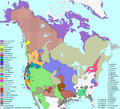History of the Americas facts for kids
The history of the Americas tells the story of North America and South America. This includes Central America and the Caribbean. It starts when people moved to these lands from Asia and maybe Oceania. This happened during a very cold time called an Ice age.
These early groups were mostly separate from people in the "Old World" (Europe, Asia, Africa). This changed when Europeans arrived in the 10th and 15th centuries.
The first people in the Americas were hunter-gatherers. They were the ancestors of today's Native Americans. Many experts believe they came across the Bering Land Bridge. This land, called Beringia, is now covered by the cold waters of the Bering Strait. Small groups of early people, called Paleo-Indians, likely followed large animals like mammoths. Some people might have also traveled along the northern Pacific coast on ice.
Over time, the ways of life brought by these first people changed. They led to amazing cultures like the Iroquois in North America and the Quechuas in South America. These cultures later grew into advanced civilizations. Some of these important civilizations include the Zapotec, Toltecs, Olmec, Maya, Aztecs, and the Inca.
Contents
North America's Ancient Civilizations
Pueblo People: Living in Stone Homes
The Puebloan peoples lived in what is now the Southwestern United States and northern Mexico. They built large stone apartment-like homes from adobe. They lived in areas like Arizona, New Mexico, Utah, and Colorado.
Chichimeca: Nomads of the North
The Mexica (Aztecs) called many semi-nomadic groups "Chichimeca." These groups lived in northern modern-day Mexico. The name meant something like "barbarian" to the Aztecs. When the Spanish arrived, they also used this name for the semi-nomadic hunter-gatherers of northern Mexico.
Zapotec: Early Writers and Builders
The Zapotec civilization began around 1500 BCE. Their writing system influenced the later Olmec people. They built a great city called Monte Alban.
Olmec: Mesoamerica's First Great Civilization
The Olmec civilization started around 1200 BCE in Mesoamerica. It ended around 400 BCE. Olmec art and ideas influenced many cultures around them even after their decline. Many believe they were the first in America to create a writing system. After the Olmecs left their cities for unknown reasons, the Maya, Zapotec, and Teotihuacan cultures grew.
Maya: A Long and Mysterious History
Maya history lasted for 3,000 years. The Maya civilization may have declined because of climate changes around the end of the 10th century.
Toltec: Nomads Who Spoke Aztec
The Toltec were a nomadic people who lived from the 10th to the 12th century. Their language was also spoken by the Aztecs.
Teotihuacan: A Powerful City and Empire
Teotihuacan (4th century BCE - 7th/8th century CE) was both a city and an empire. At its strongest, between 150 CE and the 5th century, it controlled most of Mesoamerica.
Aztec: A Mighty Empire Cut Short
The Aztec started building their empire around the 14th century. Their civilization ended suddenly when the Spanish conquistadors arrived. They lived in Mesoamerica and nearby lands. Their capital city, Tenochtitlan, was one of the largest cities ever.
South America's Ancient Civilizations
Norte Chico: The Oldest Known Civilization
The oldest known civilization in the Americas was in the Norte Chico region of modern Peru. A complex society developed in these coastal valleys between 3000 and 1800 BCE. The Quipu, a special way of recording information using knotted strings, seems to have started during the Norte Chico era.
Chavín: Trade and Farming in the Andes
The Chavín people created a trade network and developed farming. This happened as early as 900 BCE, according to some findings. Artifacts from their culture were found at a site called Chavín in modern Peru, high up at 3,177 meters. The Chavín civilization lasted from 900 BCE to 300 BCE.
Inca: Masters of the Andes
The Inca civilization was based in the great city of Cusco. They ruled the Andes region from 1438 to 1533. Their empire was called Tahuantinsuyu in Quechua, which means "the land of the four regions."
The Inca culture was very unique and advanced. They built cities with perfectly fitted stonework on many levels of mountain terrain. Terrace farming was a smart way they grew crops. There is also proof of excellent metalwork and even successful brain surgery by the Inca people.
Native Americans Today
The number of Native Americans in the U.S. is growing. This is due to population growth, changes in tribal enrollment rules, and immigration from Spanish America, especially Mexico. Many of these immigrants are also considered Hispanic.
The Impact of Slavery
Slavery played a big part in the economic growth of the New World after Europeans arrived. Enslaved people helped build roads and worked on farms. Crops like cotton, tobacco, and sugar cane, harvested by enslaved people, became very important exports for the United States and the Caribbean countries.
Other Interesting Pages
Images for kids
-
Pre-contact: distribution of North American language families, including northern Mexico
-
K'inich Kan B'alam II, the Classic period ruler of Palenque, as depicted on a stela.
-
The Great Kiva of Chetro Ketl at the Chaco Culture National Historical Park, UNESCO World Heritage Site.
-
Cliff Palace, Mesa Verde National Park, a UNESCO World Heritage Site.
-
Taos Pueblo, a UNESCO World Heritage Site, is an Ancient Pueblo belonging to a Native American tribe of Pueblo people, marking the cultural development in the region during the Pre-Columbian era.
-
White House Ruins, Canyon de Chelly National Monument
See also
 In Spanish: Historia de América para niños
In Spanish: Historia de América para niños











